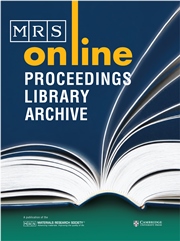Article contents
Exciton Dynamics in Ultrathin InAs/GaAs Quantum-Wells
Published online by Cambridge University Press: 15 February 2011
Abstract
We have studied the transient behaviour of a sharp emission line, which emerges close to the heavy-hole (hh) exciton photoluminescence line in a 1.6 monolayer thick InAs layer embedded in a GaAs matrix, when the light-hole (lh) exciton transition is excited. We find, that the decaytime of the sharp line is equal to the lh-exciton lifetime for excitation on resonance, but it strongly decreases for excitation off resonance. Since in our structure the energy separation between the hhand lh-exciton transitions amount to one GaAs LO phonon we conclude, that the sharp line originates from double resonant Raman scattering for off resonant excitation, whereas it is predominantly due to resonant luminescence for excitation on resonance. The strong decrease of the intensity of the sharp line due to a temperature rise from 4 to 18K proves the existence of a well confined lh-exciton state. In addition, we performed carrier capture measurements on this structure. We find a constant capture time of 20ps at the lh-exciton transition, whereas the capture time decreases step-like from 55ps to 22ps within the hh-exciton transition. This provides clear evidence for a two-step capture process, where the lh-level acts as an intermediate capture state.
Information
- Type
- Research Article
- Information
- Copyright
- Copyright © Materials Research Society 1996
References
- 1
- Cited by

